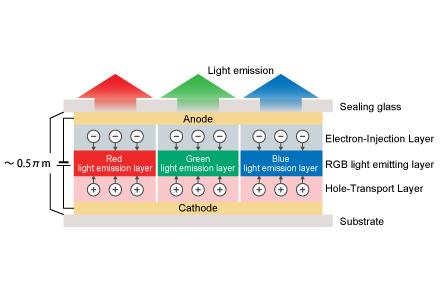
Organic electro-luminescence is an electroluminescent phenomenon that occurs when electrical energy is converted to light energy using specific types of organic material. OLED displays use the phenomenon of organic material illuminating by itself when voltage is applied.
OLED displays can reproduce pure bright colors by emitting organic materials of three primary colors of light: red, green, and blue. Black can be clearly expressed by stopping the light emission, providing high contrast, which is one of the features of OLED.
Because self-emitting diodes are used, there is no need to use backlights required for LCD panels. The simplicity of the structure allows the OLED displays to be thin and lightweight. It is also possible to make bendable OLED displays by using resin for circuit boards.
OLED displays have the features of being able to provide beautiful images and a high degree of freedom in shape with thin and light panels, as well as wide viewing angle, high video response speed, and low power consumption. Smartphones, TVs, and many other products that we use daily are starting to use this technology as the next-generation display that is better than LCD.
